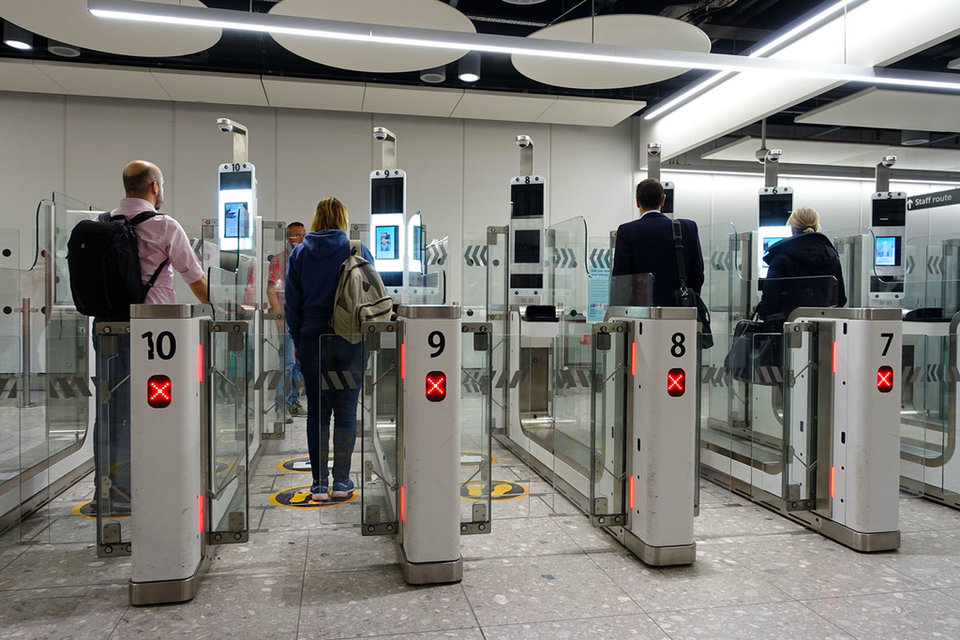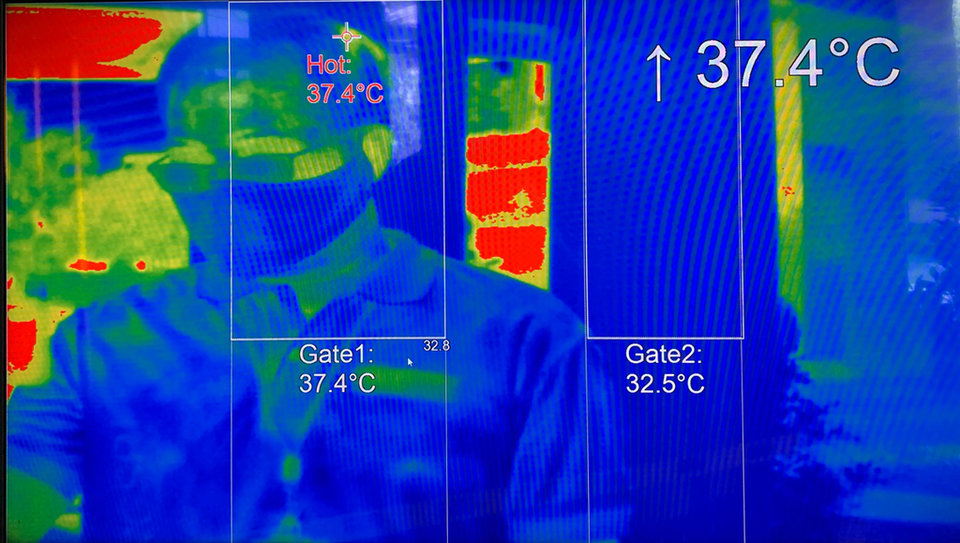Technology
The rise of touchless technology at airports
With Covid-19 creating new safety priorities for transport hubs, airports have accelerated a long-awaited transition to touchless technologies. Adele Berti takes a look at some of the most promising contact-free applications and the airports pioneering them.
Airports worldwide have been working around the clock to make their facilities coronavirus ready ever since the pandemic highlighted the need to minimise personal contact and enforce social distancing. More than anything, this has meant switching to touch-free operations and ensuring passengers can have a seamless end-to-end journey.
Fortunately for airports, the crisis did not catch them entirely unprepared. Aviation players have been deeply invested in implementing contactless technologies for several years and the pandemic is only helping to accelerate their adoption.
One such example is Avinor - which operates 44 state-owned Norwegian airports - and its partnership with travel technology company Amadeus. Earlier in July, the two companies launched an end-to-end touchless travel programme across four airports in a bid to attract world travellers during the holiday season. The solution encompasses check-in, baggage drop, security and boarding. It relies on Amadeus’s cloud-based passenger handling platform and encourages people to use their phone as a boarding pass throughout the airports.
“When we initially moved to the cloud back in 2015, we were doing something no one else was but now we're seeing airports adopting that technology and the idea was always that it needs to be able to address any disruption that airports face,” says Amadeus Airport IT global head of strategy Iyad Hindiyeh. “Nobody had Covid-19 in mind or the complexity it would have had, but the solutions that we had are helping airports increase passengers’ trust [in the fact] that their processes are safer and more secure than they used to be.”
For the past few months, Amadeus has been collaborating with other hubs worldwide to implement its cloud-based, contactless solutions in preparation for the easing of lockdowns. Many airports have been riding this wave since the outbreak, with cutting-edge solutions already on display in Australia, the UAE and the US.
These examples, he claims, are painting a clear picture of what life after coronavirus will be like for aviation. “The [touch-free] trend is there to stay and the whole passenger flow within an airport and passenger service will have to adapt,” he says. But just how is this trend coming to life across the world’s airports, and what technologies are enabling it?
Image:
Image:
Select the icons for more information
Biometrics at e-gates and as digital ID
Often branded as the future of air travel, biometric technology is playing a crucial role in enabling touch-free operations. A prime example is Dubai International Airport, which recently introduced a ‘smart tunnel’ at immigration control that uses facial recognition to speed up queues.
This concept is further amplified by companies like Vision-Box, which is using biometrics to eliminate manual and face-to-face operations at e-gates and several airport touchpoints.
Meanwhile, two aviation leaders - air transport technology giant SITA and the International Air Transport Association (IATA) - are developing similar biometric-based passenger processing solutions. In fact, both SITA’s Smart Path and IATA’s One ID are bidding to use face scans as potential replacements to passports and boarding passes to make a traveller’s journey throughout the airport entirely touchless.

Image: 1000 Words / Shutterstock.com
Taking control with mobile phones
Covid-19 is making airport operations more smartphone centric than ever. Many airlines are currently relying on apps to communicate with their clients, inform them about the status of their luggage and alert them when it’s time to board.
Similarly, phones are a key enabler of Amadeus’s contactless operations in Norway. Here, passengers are encouraged to use their mobile devices as a boarding pass and coupon to print the bag tag, altogether removing the need to touch digital kiosks and similar surfaces.
Retailers and restaurants are also using mobiles to avoid table service and contacts with staff. For example, restaurants at Seattle-Tacoma International Airport have adopted the Grab app, which allows users to scan a QR code and order online. Meanwhile, employees at Hartsfield-Jackson Atlanta International Airport are relying on the Kolo Hygiene app to track hygiene-related chores around the hub.
Passengers may now also use social distancing-focused wayfinding apps like Wisefly, which sends out alerts when they get too close to others.

Images:
Movement, voice and temperature sensors
While still in their infancy compared to biometrics and mobiles, motion and sensor-based technologies are starting to play a key role in minimising social contact. For example, Abu Dhabi International Airport has rolled out motion-based elevators across its terminals where users can indicate their destination floor by waving their hands.
Similarly, passengers at Australia’s Avalon Airport can now interact with kiosks and bag drop displays by moving their head. The company behind this technology, called Elenium Automation, is also fitting devices with voice recognition technology.
Moreover, the age of coronavirus has triggered widespread adoption of temperature and heat sensors or cameras to identify potentially infectious patients from a remote position. An example is Abu Dhabi, where Etihad Airways and Elenium Automation are testing the feasibility of self-service kiosks that monitor a passenger’s temperature, heart and respiratory rate.

Security slots and health passports before flying
Pre-flight planning is something that Amadeus is strongly pushing for. “Some studies show that airports will lose anywhere between 50-60% of their capacity because they need to create space [for social distancing],” explains Hindiyeh. “The idea is that [our] technology is not only available at an airport premise, but it can also be anywhere the passenger is and you can start the journey from that point.”
Many other companies are encouraging remote planning and check-in to minimise contact and speed up queues. This is the case of Manchester Airport, which is currently allowing passengers to pre-book a 15-minute slot at security lanes to avoid waiting in line.
Finally, with more waves of the outbreak expected in the months to come, some companies are developing health apps and solutions for passengers and staff to use before reaching the airport. For example, the blockchain-powered APPII app is working to provide a digital health passport for airport workers, while Israeli company Pangea is currently branding a Covid-19 immunity passport that allows airports to determine if the person is virus free or has immunity.

A walkway between terminals at Manchester Airport, UK.
Biometrics at e-gates and as digital ID
Often branded as the future of air travel, biometric technology is playing a crucial role in enabling touch-free operations. A prime example is Dubai International Airport, which recently introduced a ‘smart tunnel’ at immigration control that uses facial recognition to speed up queues.
This concept is further amplified by companies like Vision-Box, which is using biometrics to eliminate manual and face-to-face operations at e-gates and several airport touchpoints.
Meanwhile, two aviation leaders - air transport technology giant SITA and the International Air Transport Association (IATA) - are developing similar biometric-based passenger processing solutions. In fact, both SITA’s Smart Path and IATA’s One ID are bidding to use face scans as potential replacements to passports and boarding passes to make a traveller’s journey throughout the airport entirely touchless.

Image: 1000 Words / Shutterstock.com
Taking control with mobile phones
Covid-19 is making airport operations more smartphone centric than ever. Many airlines are currently relying on apps to communicate with their clients, inform them about the status of their luggage and alert them when it’s time to board.
Similarly, phones are a key enabler of Amadeus’s contactless operations in Norway. Here, passengers are encouraged to use their mobile devices as a boarding pass and coupon to print the bag tag, altogether removing the need to touch digital kiosks and similar surfaces.
Retailers and restaurants are also using mobiles to avoid table service and contacts with staff. For example, restaurants at Seattle-Tacoma International Airport have adopted the Grab app, which allows users to scan a QR code and order online. Meanwhile, employees at Hartsfield-Jackson Atlanta International Airport are relying on the Kolo Hygiene app to track hygiene-related chores around the hub.
Passengers may now also use social distancing-focused wayfinding apps like Wisefly, which sends out alerts when they get too close to others.

Movement, voice and temperature sensors
While still in their infancy compared to biometrics and mobiles, motion and sensor-based technologies are starting to play a key role in minimising social contact. For example, Abu Dhabi International Airport has rolled out motion-based elevators across its terminals where users can indicate their destination floor by waving their hands.
Similarly, passengers at Australia’s Avalon Airport can now interact with kiosks and bag drop displays by moving their head. The company behind this technology, called Elenium Automation, is also fitting devices with voice recognition technology.
Moreover, the age of coronavirus has triggered widespread adoption of temperature and heat sensors or cameras to identify potentially infectious patients from a remote position. An example is Abu Dhabi, where Etihad Airways and Elenium Automation are testing the feasibility of self-service kiosks that monitor a passenger’s temperature, heart and respiratory rate.

Security slots and health passports before flying
Pre-flight planning is something that Amadeus is strongly pushing for. “Some studies show that airports will lose anywhere between 50%-60% of their capacity because they need to create space [for social distancing],” explains Hindiyeh. “The idea is that [our] technology is not only available at an airport premise, but it can also be anywhere the passenger is and you can start the journey from that point.”
Many other companies are encouraging remote planning and check-in to minimise contact and speed up queues. This is the case at Manchester Airport, which is currently allowing passengers to pre-book a 15-minute slot at security lanes to avoid waiting in line.
Finally, with more waves of the outbreak expected in the months to come, some companies are developing health apps and solutions for passengers and staff to use before reaching the airport. For example, the blockchain-powered APPII app is working to provide a digital health passport for airport workers, while Israeli company Pangea is currently branding a Covid-19 immunity passport that allows airports to determine if the person is virus free or has immunity.

A walkway between terminals at Manchester Airport, UK.